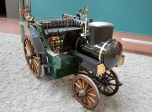Cars from 1878 to 1920 - The forerunners
Serpollet type H
1902
Code 0208
Body style: two-seat racer
Léon Serpollet was a master craftsman and a firm believer in the power of steam. His flash boiler cars were powerful, fast (with speeds of up to 110 kph (70 mph)), extremely reliable and quiet. However, their big drawback was their cost, and Serpollet worked hard to bring this down, through a partnership with an US backer, Frank Gardner. The American bankrolled Serpollet’s project, enabling the Type H to enter the big motor races from Paris to other world cities. Seven of Serpollet’s cars started the Paris-Madrid race on 24 May 1903. Although the race was halted by the government in Bordeaux, after multiple accidents, the results for Serpollet were excellent, proving the reliability of the make. All seven cars finished the race, the highest finisher being driven by amateur sportsman Le Blon.
Lessons in aerodynamics were learned and implemented on the seven cars of the Serpollet stable, four-cylinder motor vehicles pulling approximately 40 hp. The fastest of them came close to 140 kph (90 mph). The car features two aerodynamic forms (front and rear) with a very simple profile, sitting on a chassis with a long wheelbase. The two sections are linked by a driving compartment, with elevated seating, as required by the rules of the Automobile Club de France. The condenser and cooler is at the front and the boiler at the rear.
The model in the museum, with Code 0208, is the only surviving example of these famous Type H racers. It had been kept for many years in a rather dilapidated state in the Conservatoire National des Arts et Métiers de Paris (CNAM), but was restored for the first time in the 1950s by the collector Liber, before being sold to the Schlumpf Brothers, who carried out a further, very careful restoration, with particular attention to the colours.



















